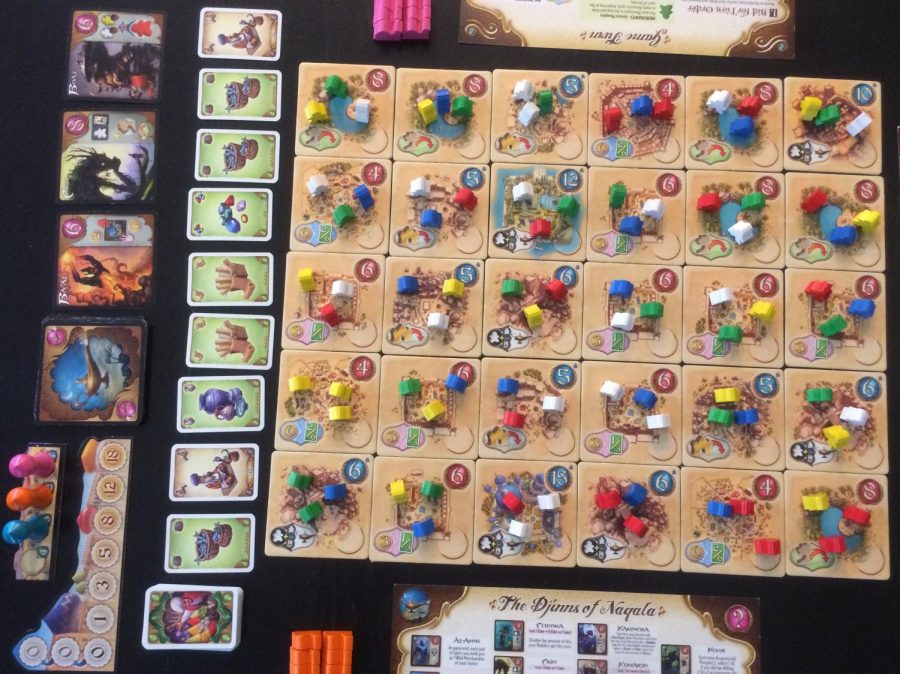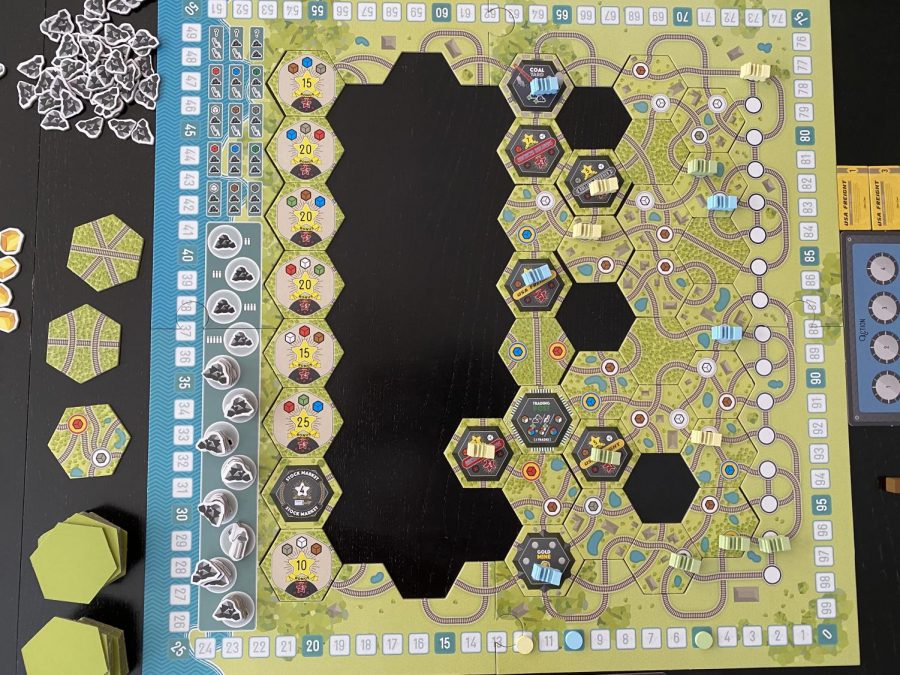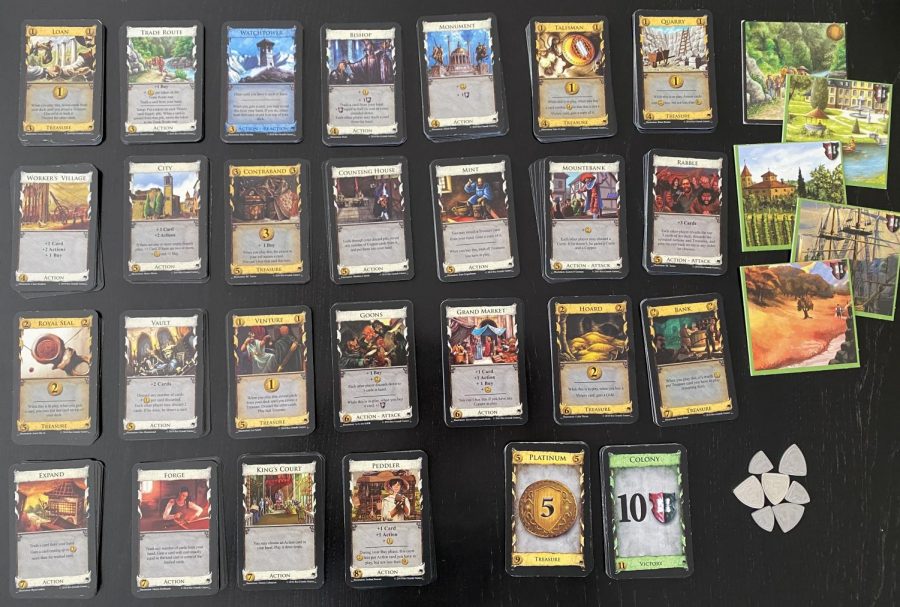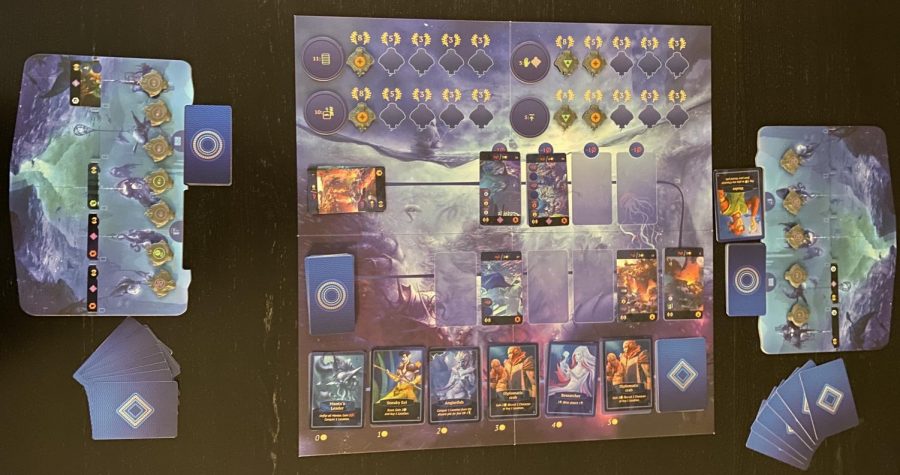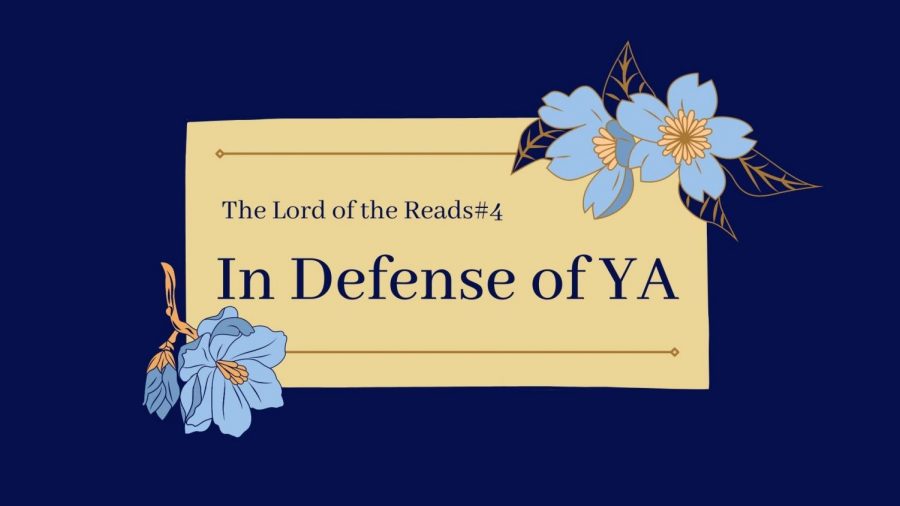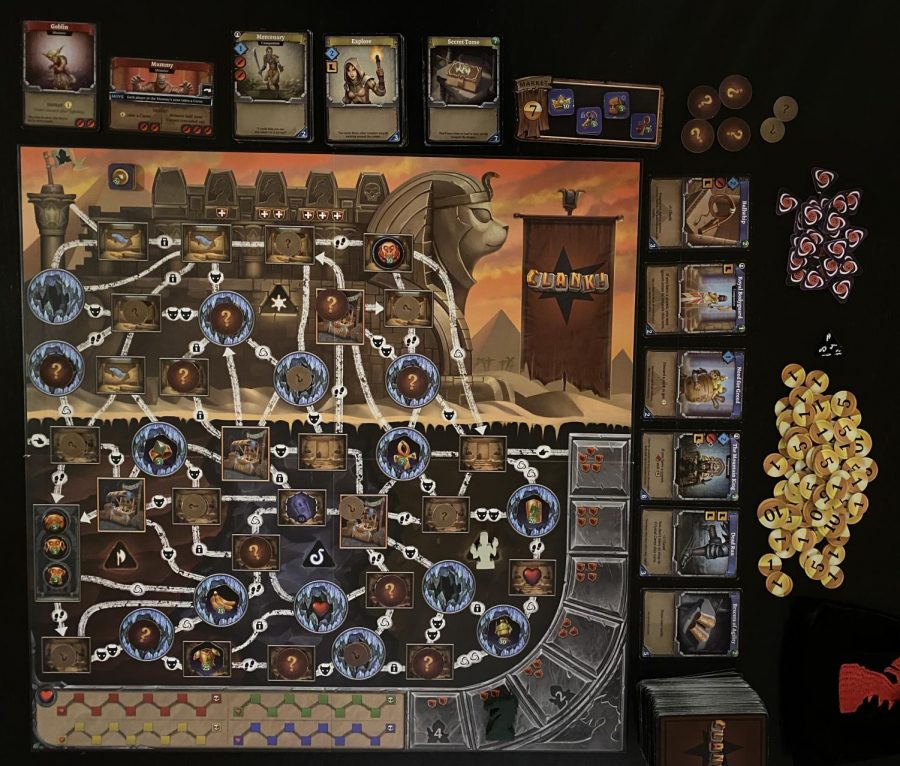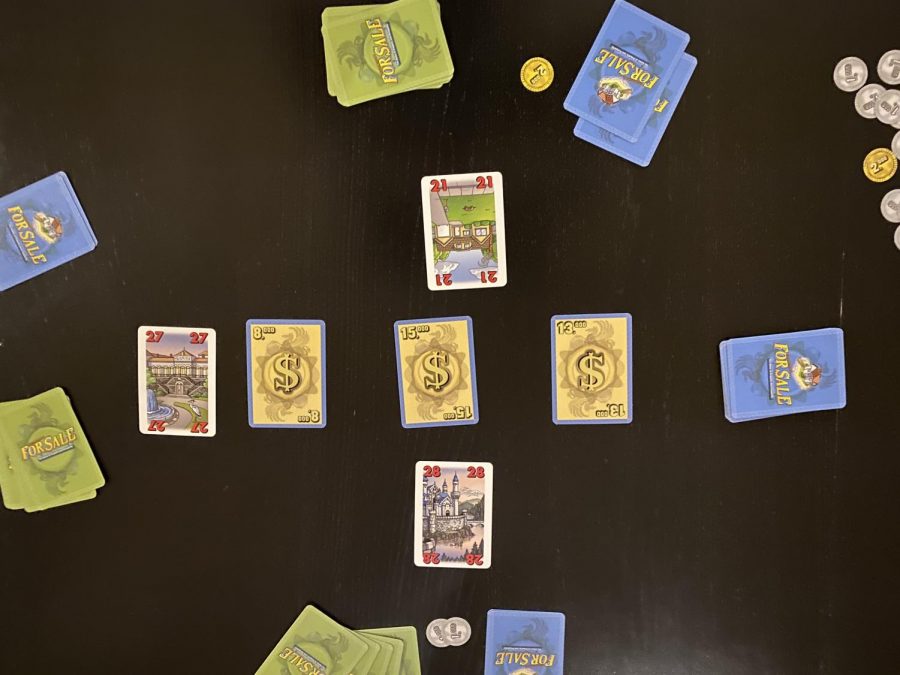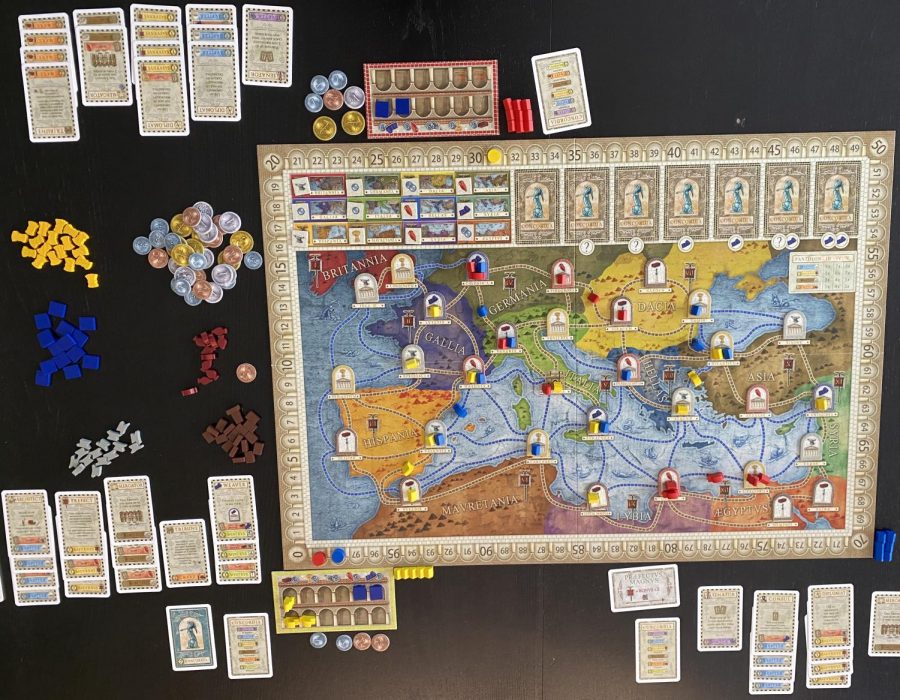As you enter the Land of 1001 Nights, news spreads that the Sultan recently died. That means that control of Naquala is up for grabs, but you must maneuver the five tribes before your competitors beat you to the crown!
Each turn consists of moving different colored meeples around the board in a mancala-like style. However, the game is a point salad, where every action you take is beneficial. The challenge is the figure out how to maximize your points without opening up incredible moves for your opponents.
How to Play
30 tiles in a 6×5 grid comprise the gameboard. Each tile starts with three meeples randomly pulled from the bag. Near the board, there are nine resource cards face-up and the rest in a face-down stack. Also, shuffle the Djinn cards and place them in a face-down stack with three cards face-up. The turn order and bid order track are placed next to the board as well. The general supply consists of gold coins, palm trees, and palaces.
Each player will get a player marker in their color, eight camels, and 50 gold coins. In a 2-player game, they get a second player marker and three additional camels. Each player also gets a player overview card, and I’ve organized the following rules section in the same way those cards are formatted.
1. Bid for Turn Order
In the order that the player markers are on the bid order track, each player pays a number of gold coins to place their player marker on the corresponding space of the turn order track. Only one player can occupy each space, so you need to pay a larger amount of gold coins to outbid someone for turn order. However, multiple players can bid zero gold. In these cases, all players who previously bid zero are pushed back and will play later in the round.
2. Player Actions
Starting with the highest bidder and continuing down the turn order track, each player takes a turn through the following steps.
First, they move their turn order marker from the turn order track to the first empty space on the bid order track. That means that playing sooner in one round will cause you to bid sooner in the next round.
Next, you must move meeples. Choose the tile you want to start at and pick up all of the meeples there. One at a time, drop a meeple on a tile orthogonal to the previous tile until you have placed all of the meeples.
The last meeple you drop must match the color of a meeple already on the final tile. Remove all of the meeples of that color from that tile. If the tile is empty now, which would happen if there were only meeples of one color, you take control of the tile. You will receive points based on the value of the tile.
Now you will take a tribe action based on which color meeples you removed. You will keep viziers, the yellow meeples, in front of you. They are worth one point each and 10 points for each player who has fewer Viziers than you. You will also keep Elders, the white meeples, in front of you. Elders are worth two points each but are also used for acquiring Djinns and using their powers. The other tribes give you points through an immediate effect, and the meeples for those colors are placed in the bag.
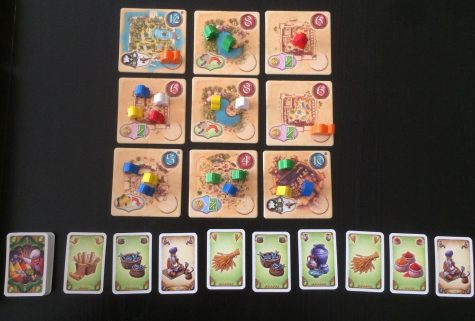
Each card in the resource row is numbered from one to nine, where one is furthest away from the resource deck. You will take a number of resources from the row starting at one for each merchant, green meeple, you remove. Some resource cards are Fakirs that can be used for the other two tribe’s actions or to activate a Djinn. The majority of the resource cards are merchandise. You will score points for collecting sets of different merchandise cards. After you take resource cards, the next card in the row becomes the number one card.
When you remove builders, the blue meeples, you will receive gold coins. Each builder you removed gives you one gold coin per blue-numbered space in the 3×3 grid of tiles centered at the tile you finished movement on. You can spend any number of Fakirs to increase the number of builders you had. In addition to using gold for bidding, each gold you have at the end of the game is also worth one point.
The last tribe, the red meeples, are assassins, which can kill meeples in two ways. One option is to kill any meeple that is in front of another player. The second option is to kill one meeple on a tile within a range of your assassins. The range of your assassins is one tile per assassin you had. You can also increase your range by playing Fakirs from your hand, but you still can only remove one meeple. As a bonus, if killing a meeple empties the tile, you get to place one of your camels on that tile.
After your tribe action, you may perform the tile action. Some tiles have a mandatory action that requires you to place either a palm tree or palace on it. Those structures give additional points to the player who controls the tile. Another tile action allows you to buy resources from the market. Small markets allow you to pay three gold to take any of the first three cards in the row. Large markets allow you to pay six gold to take any two of the first six cards in the row.
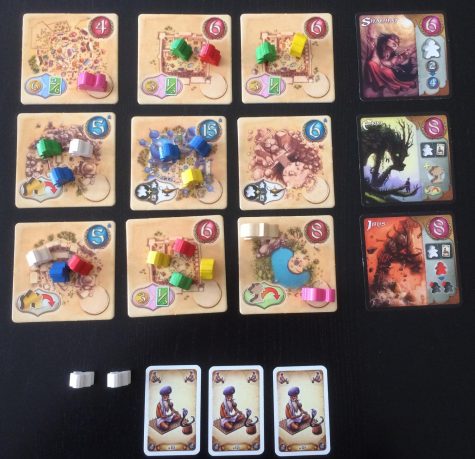
Sacred places allow you to buy a Djinn. A Djinn costs two elders or one elder and one Fakir. You can pick any of the Djinns that are face-up. In addition to points shown on them, Djinns give you a special power. Some of these powers are automatic, but others cost a Fakir, elder, or combination of those to use them. All of the Djinns in the game are explained on the back of the player overview cards.
Before you end your turn, you can sell some of your merchandise cards if you are short on gold coins. You must discard a set of all different merchandise cards and get gold determined by how many cards you sold. The amount of gold you get from this action is equal to the number of points you would get if you keep the resources until the end of the game, but saving resources allows you to increase the size of your sets throughout the game.
3. Clean-up
It is not until after all players complete their turn that the resource row and Djinns are refilled. That is another reason why playing sooner may be important.
End of the Game
The game ends after a round where a player placed their last camel or there are no more legal moves to make. At that point, you can use the given score sheets to add up the points and see who is the winner.
Final Thoughts
I’ll start by telling you that Five Tribes is a really enjoyable game. Let’s start with the pros and then go into some of the cons.
To begin with, the artwork and components are fantastic. The palm trees and palaces are 3D wooden pieces, which shows the dedication put into designing the game. They could’ve used discs or cubes with icons on them for a lot of the components, but they didn’t.
For replayability, there are enough scoring methods that the game feels different each time. The tiles and starting meeples are also randomized. Not to mention that different Djinns will appear in each game, and you don’t even have to get Djinns if you don’t want to.
The game experience is also fun. Whether it’s your turn or not, you are constantly studying the board for your next moves, trying to combine a tribe and tile action. And when it is your turn, everything you do is simple and clean. Dropping meeples is straightforward and your tribe and tile actions are based on a single point of the move. That makes the many possibilities slightly less intimidating because you can work backward starting with what you want to do this turn and ending at what meeples you are going to move to accomplish that.
You can’t plan too far in advance because your opponents can easily mess up your plan by stealing your move entirely or just by dropping meeples in places you don’t want them. But, the player interaction in this game is surprising quite friendly. Even if your move gets blocked, each move will create some new options for the next player that can sometimes be worth a lot of points.
There is the possibility of one player opening up good moves for the next player, which isn’t the fairest. However, that’s merely an illusion because that player happened to pick the new move over another move that was already present. Because this is a point salad game, the point differential between the new move and a previous move is not significant.
Now, we start to get to some of the negative aspects of the game. First, the box says 40-80 minutes which is usually how long the game takes. Sometimes, the game feels like it is taking longer because of analysis paralysis. Some players may try to find every possible option to see which one gives them the most points, which adds a lot of downtime because there are so many possible moves.
The bidding for turn order is a necessary part of the game because people can evaluate the current game state and determine how much they are willing to pay to decide their next move. The problem with the bidding is that you are paying your points to go sooner. If I want to save my money and always bid low, it’s a valid strategy. The highest bid to secure going first is 18 gold, but it is unlikely that there is ever a move worth enough points that someone would bid 18 gold to make it, especially when you consider the number of moves that open up every time.
I think it’s interesting that the last player of the round can set up a valuable move because they bid last the next round, so they can make sure they bid the highest and get the move they set up. Other than that, I think the game could have done better with the bidding mechanism.
In a 2-player game, each player gets two player markers, so you can take up to four turns in a row by playing the last two turns of one round and the first two turns of another round. The two player game seems like a team variant ruleset, but each player plays as both team members. Because of this, I prefer the game at 3-4 players.
There is also a learning curve to the game. While you can technically play the game, it takes a game or two to be comfortable enough with the rules to perform decently. The game is sometimes overwhelming to new players, so I would make sure you play this with the right group of people. There are still new combinations and ways to counter certain strategies that you will see after a dozen games.
To recap, I would not recommend this game if you are likely to play with someone with analysis paralysis. This is also not a game you want to play if you are looking for long-term decisions, since this game wants you to think about what you can do at the moment. However, you will like this game if you like the idea of solving a puzzle by dropping meeples on tiles to determine your actions for the turns. This game is also a good choice for a heavy game that doesn’t have too many rules.
Despite some analysis paralysis issues, the game has amazing components and is free of unnecessary rules that more than compensate for its minor issues. Because of this, I give Five Tribes a 9 out of 10.

